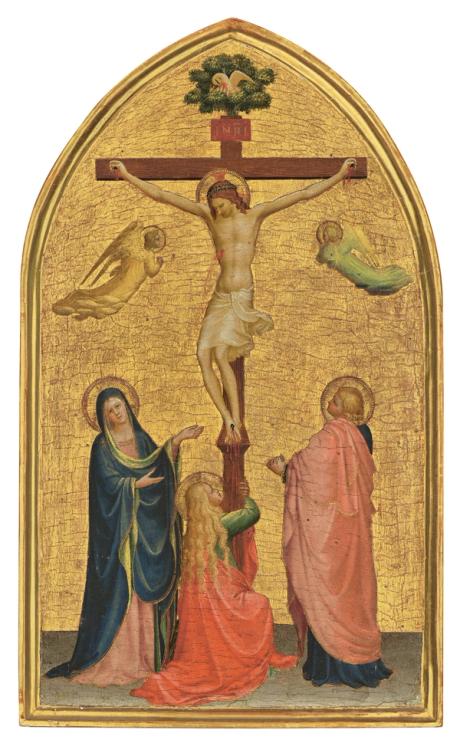
Fra Angelico’s autograph works at auction are rare as hen’s teeth. But in its July 6 Old Masters Evening Sale, Christie’s will offer an early 15th-century gold-ground crucifixion scene, rediscovered in the 1990s as a work by the early Renaissance Florentine artist. . It is estimated between 4 and 6 million pounds sterling.
“Great works of art have their own inevitability; and it seems astonishing that the name of Fra Angelico has not been invoked before in connection with a devotional panel of Christ on the cross, with the Virgin, Saint John the Evangelist and the Magdalen,” wrote Francis Russell, vice-president British president of Christie’s, in an article in the Burlington Review in May 1996, which first revealed the new attribution. The work had previously been attributed to Lorenzo Monaco, in whose Florentine workshop Fra Angelico is said to have been trained.
Russell describes the “thrilling moment” he first laid on the board in the early 1990s: “Intensely personal, it also expresses his [Fra Angelico’s] understanding of the revolutionary achievement of the great Florentine sculptors of his time. The tenderness with which Christ is represented responds to the raw emotion of the Virgin and the pathos of the kneeling Magdalen clinging to the Cross, the thickness of which is revealed by the position of her arms. Each gesture is perfectly weighed. The sensitivity of the painter’s use of color is evident in the way the blood of Christ and the pelican above is matched to the dress of the Magdalen. With Fra Angelico, nothing was accidental.
Although the exact date is not known, the panel is thought to have been painted between around 1419 and 1424. This attribution has been supported by five scholars who have written about the work: Diane Cole Ahl, Laurence Kanter, Giorgio Bonsanti, Gerardo de Simone and Ginevra Utari, as well as Carl Brandon Strehlke, curator emeritus of the Philadelphia Museum of Art, who organized the 2019 exhibition Fra Angelico and the rise of the Florentine Renaissance at the Prado in Madrid. The exhibition celebrated the museum’s acquisition of a large Madonna by the artist and the donation of a small panel (previously attributed to Fra Angelico by Russell).
Angelo Tartuferi and Arturo Galansino, the curators of an upcoming Fra Angelico exhibition at Palazzo Strozzi in Florence (September 26, 2025-January 25, 2026), for which the loan of Christie’s crucifixion work has been requested, also supported attribution. “As far as I know, no one has doubted Angelico’s paternity,” Russell says.
The panel is thought to have been acquired by William Bingham Baring, 2nd Lord Ashburton (1799-1864), in the 18th century, and passed down through the family. When Russell first saw the work at the Sellers’ home in the early 1990s, he was convinced it was a work by Fra Angelico because of the panel’s “exceptional distinction…a combination of its refined caliber, detailed morphology and dazzling color could have led to no other conclusion.” He adds: “There is no assisting evidence, so I believe the photo is entirely by Fra Angelico.”
The work was examined by a restorer “with intimate knowledge of Fra Angelico’s technique”, says Russell, adding that “no scientific test is relevant”. It hasn’t been cleaned or restored within living memory, “although a little test was recently done on the gold floor,” Russell says. “Although the figures are in exceptionally good condition, some areas of the gold background have been retouched in the past.”
There are only two recorded auctions of works by Fra Angelico in this century: a small panel sold by Christie’s in New York last year for $4.7 million (with fees) and a crucifixion slightly larger with saints, which is subject to an export ban, sold in Italy in 2003 for $1.2 million (with fees). “The biggest Madonna bought by the Prado was bought at a reduced price…[The Virgin of the Pomegranate which was purchased privately via a “gentleman’s agreement” in 2016 from the Spanish Alba ducal collection, for €18m] because Spanish regulations prohibited its export,” explains Russell.
The work is not currently guaranteed and, says Russell, it will not be available for warranty.
